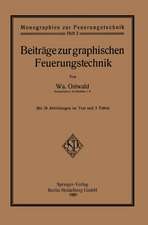Industrial Aromatic Chemistry: Raw Materials · Processes · Products
Autor Heinz-Gerhard Franck, Jürgen W. Stadelhoferen Limba Engleză Paperback – 10 dec 2011
Preț: 404.29 lei
Nou
Puncte Express: 606
Preț estimativ în valută:
77.36€ • 80.78$ • 63.88£
77.36€ • 80.78$ • 63.88£
Carte tipărită la comandă
Livrare economică 15-29 aprilie
Preluare comenzi: 021 569.72.76
Specificații
ISBN-13: 9783642734342
ISBN-10: 3642734340
Pagini: 508
Ilustrații: XIV, 486 p.
Dimensiuni: 170 x 244 x 27 mm
Greutate: 0.8 kg
Ediția:Softcover reprint of the original 1st ed. 1988
Editura: Springer Berlin, Heidelberg
Colecția Springer
Locul publicării:Berlin, Heidelberg, Germany
ISBN-10: 3642734340
Pagini: 508
Ilustrații: XIV, 486 p.
Dimensiuni: 170 x 244 x 27 mm
Greutate: 0.8 kg
Ediția:Softcover reprint of the original 1st ed. 1988
Editura: Springer Berlin, Heidelberg
Colecția Springer
Locul publicării:Berlin, Heidelberg, Germany
Public țintă
ResearchCuprins
1 History.- 2 The nature of the aromatic character.- 2.1 Molecular considerations.- 2.2 Mechanistic considerations.- 2.3 Nomenclature.- 3 Base materials for aromatic chemicals.- 3.1 Origin of fossil raw materials and their composition.- 3.2 Coal.- 3.3 Crude oil.- 3.4 Production of aromatic hydrocarbons with zeolites.- 3.5 Renewable raw materials.- 3.6 Summary review of processes for the production of aromatics.- 4 Production of benzene, toluene and xylenes.- 4.1 History.- 4.2 Pre-treatment of mixtures containing crude aromatics.- 4.3 Separation of mixed aromatics into individual constituents.- 4.4 Dealkylation, isomerization and disproportionation reactions of BTX aromatics.- 4.5 Quality standards.- 4.6 Economic data.- 4.7 Process review.- 5 Production and uses of benzene derivatives.- 5.1 Ethylbenzene.- 5.2 Cumene.- 5.3 Phenol.- 5.4 Benzene hydrogenation — cyclohexane.- 5.5 Nitrobenzene and aniline.- 5.6 Alkylbenzenes and alkylbenzene sulfonates.- 5.7 Maleic anhydride.- 5.8 Chlorobenzenes.- 5.9 Process review.- 6 Production and uses of toluene derivatives.- 6.1 Nitro-derivatives of toluene.- 6.2 Benzoic acid.- 6.3 Chlorine derivatives of toluene.- 6.4 Sulfonic acid derivatives of toluene.- 6.5 Toluenesulfonyl chloride.- 6.6 Other toluene derivatives.- 7 Production and uses of xylene derivatives.- 7.1 o-Xylene and its derivatives.- 7.2 m-Xylene and its derivatives.- 7.3 p-Xylene and its derivatives.- 8 Polyalkylated benzenes — production and uses.- 8.1 Pseudocumene.- 8.2 Mesitylene.- 8.3 Durene.- 8.4 Other eumene derivatives.- 8.5 Indan and indene.- 9 Naphthalene — production and uses.- 9.1 History.- 9.2 Naphthalene recovery.- 9.3 Naphthalene derivatives.- 9.4 Process review.- 10 Alkylnaphthalenes and other bicyclic aromatics-production and uses.- 10.1 Biphenyl.- 10.2 Methylnaphthalenes.- 10.3 Acenaphthene/acenaphthylene.- 11 Anthracene — production and uses.- 11.1 Production of anthracene.- 11.2 Production of anthraquinone.- 11.3 Anthraquinone derivatives.- 11.4 Higher condensed dyes from anthraquinone.- 11.5 Anthraquinone as a catalyst in the production of hydrogen peroxide.- 11.6 Wood pulping with anthraquinone.- 12 Additional polynuclear aromatics — production and uses.- 12.1 Phenanthrene.- 12.2 Fluorene.- 12.3 Fluoranthene.- 12.4 Pyrene.- 13 Production and uses of carbon products from mixtures of condensed aromatics.- 13.1 Pyrolysis of aromatic hydrocarbon mixtures in the liquid phase.- 13.2 Pyrolysis of mixtures of aromatics in the gas phase — Carbon black production.- 14 Aromatic heterocyclics — production and uses.- 14.1 Five-membered ring heterocyclics.- 14.2 Six-membered ring heterocyclics.- 14.3 Pyrimidine.- 14.4 Triazines.- 14.5 Condensed heterocyclics.- 15 Toxicology/Environmental aspects.- 15.1 Basic toxicological considerations.- 15.2 Aspects of occupational medicine and legislation.- 15.3 Environmental aspects and biological degradation of aromatics.- 16 The future of aromatic chemistry.














